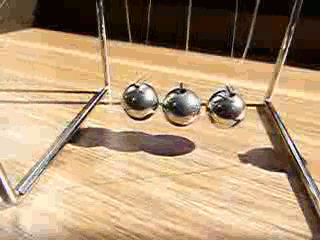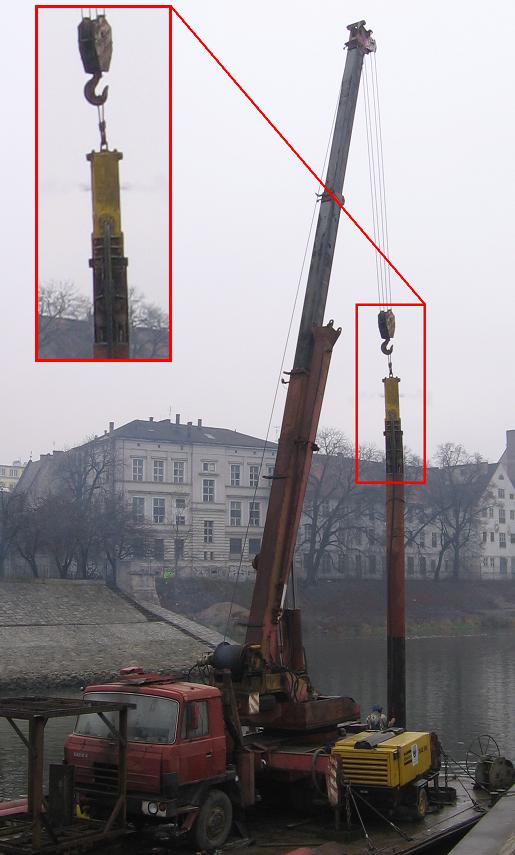Impact (mechanics) on:
[Wikipedia]
[Google]
[Amazon]
 In
In

 A nail is pounded with a series of impacts, each by a single
A nail is pounded with a series of impacts, each by a single
 Road traffic accidents usually involve impact loading, such as when a car hits a traffic bollard, water hydrant or tree, the damage being localized to the impact zone. When vehicles collide, the damage increases with the relative
Road traffic accidents usually involve impact loading, such as when a car hits a traffic bollard, water hydrant or tree, the damage being localized to the impact zone. When vehicles collide, the damage increases with the relative
 In
In mechanics
Mechanics () is the area of physics concerned with the relationships between force, matter, and motion among Physical object, physical objects. Forces applied to objects may result in Displacement (vector), displacements, which are changes of ...
, an impact is when two bodies collide. During this collision, both bodies decelerate. The deceleration causes a high force
In physics, a force is an influence that can cause an Physical object, object to change its velocity unless counterbalanced by other forces. In mechanics, force makes ideas like 'pushing' or 'pulling' mathematically precise. Because the Magnitu ...
or shock, applied over a short time period. A high force, over a short duration, usually causes more damage to both bodies than a lower force applied over a proportionally longer duration.
At normal speeds, during a perfectly inelastic collision, an object struck by a projectile will deform, and this deformation will absorb most or all of the force of the collision. Viewed from a conservation of energy
The law of conservation of energy states that the total energy of an isolated system remains constant; it is said to be Conservation law, ''conserved'' over time. In the case of a Closed system#In thermodynamics, closed system, the principle s ...
perspective, the kinetic energy
In physics, the kinetic energy of an object is the form of energy that it possesses due to its motion.
In classical mechanics, the kinetic energy of a non-rotating object of mass ''m'' traveling at a speed ''v'' is \fracmv^2.Resnick, Rober ...
of the projectile is changed into heat and sound energy, as a result of the deformations and vibrations induced in the struck object. However, these deformations and vibrations cannot occur instantaneously. A high-velocity collision (an impact) does not provide sufficient time for these deformations and vibrations to occur. Thus, the struck material behaves as if it were more brittle
A material is brittle if, when subjected to stress, it fractures with little elastic deformation and without significant plastic deformation. Brittle materials absorb relatively little energy prior to fracture, even those of high strength. ...
than it would otherwise be, and the majority of the applied force goes into fracturing the material. Or, another way to look at it is that materials actually are more brittle on short time scales than on long time scales: this is related to time-temperature superposition.
Impact resistance decreases with an increase in the modulus of elasticity, which means that stiffer materials will have less impact resistance. Resilient materials will have better impact resistance.
Different materials can behave in quite different ways in impact when compared with static loading conditions. Ductile
Ductility refers to the ability of a material to sustain significant plastic deformation before fracture. Plastic deformation is the permanent distortion of a material under applied stress, as opposed to elastic deformation, which is reversi ...
materials like steel
Steel is an alloy of iron and carbon that demonstrates improved mechanical properties compared to the pure form of iron. Due to steel's high Young's modulus, elastic modulus, Yield (engineering), yield strength, Fracture, fracture strength a ...
tend to become more brittle at high loading rates, and spalling
Spall are fragments of a material that are broken off a larger solid body. It can be produced by a variety of mechanisms, including as a result of projectile impact, corrosion, weathering, cavitation, or excessive rolling pressure (as in a ball ...
may occur on the reverse side to the impact if penetration doesn't occur. The way in which the kinetic energy is distributed through the section is also important in determining its response. Projectiles apply a Hertzian contact stress at the point of impact to a solid body, with compression stresses under the point, but with bending
In applied mechanics, bending (also known as flexure) characterizes the behavior of a slender structural element subjected to an external Structural load, load applied perpendicularly to a longitudinal axis of the element.
The structural eleme ...
loads a short distance away. Since most materials are weaker in tension than compression, this is the zone where cracks tend to form and grow.
Applications

 A nail is pounded with a series of impacts, each by a single
A nail is pounded with a series of impacts, each by a single hammer
A hammer is a tool, most often a hand tool, consisting of a weighted "head" fixed to a long handle that is swung to deliver an impact to a small area of an object. This can be, for example, to drive nail (fastener), nails into wood, to sh ...
blow. These high velocity impacts overcome the static friction between the nail and the substrate. A pile driver achieves the same end, although on a much larger scale, the method being commonly used during civil construction projects to make building and bridge foundations. An impact wrench
An impact wrench (also known as an impactor, impact gun, air wrench, air gun, rattle gun, torque gun, windy gun) is a socket wrench power tool designed to deliver high torque output with minimal exertion by the user, by storing energy in a ro ...
is a device designed to impart torque impacts to bolts to tighten or loosen them. At normal speeds, the forces applied to the bolt would be dispersed, via friction, to the mating threads. However, at impact speeds, the forces act on the bolt to move it before they can be dispersed. In ballistics
Ballistics is the field of mechanics concerned with the launching, flight behaviour and impact effects of projectiles, especially weapon munitions such as bullets, unguided bombs, rockets and the like; the science or art of designing and acceler ...
, bullets utilize impact forces to puncture surfaces that could otherwise resist substantial forces. A rubber sheet, for example, behaves more like glass at typical bullet speeds. That is, it fractures, and does not stretch or vibrate.
The field of applications of impact theory ranges from the optimization of material processing, impact testing, dynamics of granular media to medical applications related to the biomechanics of the human body, especially the hip- and knee-joints. Also, it has vast applications in the automotive and military industries.
Impacts causing damage
 Road traffic accidents usually involve impact loading, such as when a car hits a traffic bollard, water hydrant or tree, the damage being localized to the impact zone. When vehicles collide, the damage increases with the relative
Road traffic accidents usually involve impact loading, such as when a car hits a traffic bollard, water hydrant or tree, the damage being localized to the impact zone. When vehicles collide, the damage increases with the relative velocity
Velocity is a measurement of speed in a certain direction of motion. It is a fundamental concept in kinematics, the branch of classical mechanics that describes the motion of physical objects. Velocity is a vector (geometry), vector Physical q ...
of the vehicles, the damage increasing as the square of the velocity since it is the impact kinetic energy
In physics, the kinetic energy of an object is the form of energy that it possesses due to its motion.
In classical mechanics, the kinetic energy of a non-rotating object of mass ''m'' traveling at a speed ''v'' is \fracmv^2.Resnick, Rober ...
(1/2 mv2) which is the variable of importance. Much design effort is made to improve the impact resistance of cars so as to minimize user injury. It can be achieved in several ways: by enclosing the driver and passengers in a safety cell for example. The cell is reinforced so it will survive in high speed crashes, and so protect the users. Parts of the body shell outside the cell are designed to crumple progressively, absorbing most of the kinetic energy which must be dissipated by the impact.
Various impact test are used to assess the effects of high loading, both on products and standard slabs of material. The Charpy test and Izod test are two examples of standardized methods which are used widely for testing materials. Ball or projectile drop tests are used for assessing product impacts.
The ''Columbia'' disaster was caused by impact damage when a chunk of polyurethane foam
Polyurethane foam is a solid polymeric foam based on polyurethane chemistry. As a specialist synthetic fibre, synthetic material with highly diverse applications, polyurethane foams are primarily used for thermal insulation and as a cushioning mat ...
impacted the carbon fibre
Carbon fiber-reinforced polymers (American English), carbon-fibre-reinforced polymers ( Commonwealth English), carbon-fiber-reinforced plastics, carbon-fiber reinforced-thermoplastic (CFRP, CRP, CFRTP), also known as carbon fiber, carbon comp ...
composite wing of the Space Shuttle
The Space Shuttle is a retired, partially reusable launch system, reusable low Earth orbital spacecraft system operated from 1981 to 2011 by the U.S. National Aeronautics and Space Administration (NASA) as part of the Space Shuttle program. ...
. Although tests had been conducted before the disaster, the test chunks were much smaller than the chunk that fell away from the booster rocket and hit the exposed wing.
When fragile items are shipped, impacts and drops can cause product damage. Protective packaging
Packaging is the science, art and technology of enclosing or protecting products for distribution, storage, sale, and use. Packaging also refers to the process of designing, evaluating, and producing packages. Packaging can be described as a coo ...
and cushioning help reduce the peak acceleration by extending the duration of the shock or impact.
See also
* Charpy impact test * Coefficient of restitution *Compression (physical)
In mechanics, compression is the application of balanced inward ("pushing") forces to different points on a material or structure, that is, forces with no net sum or torque directed so as to reduce its size in one or more directions.Ferdinand ...
* Cushioning
* Fall factor
In lead climbing using a dynamic rope, the fall factor (''f'') is the ratio of the height (''h'') a climber falls before the climber's rope begins to stretch and the rope length (''L'') available to absorb the energy of the fall,
:f = \frac.
I ...
* Impact driver
* Impact sensor
* Impact wrench
An impact wrench (also known as an impactor, impact gun, air wrench, air gun, rattle gun, torque gun, windy gun) is a socket wrench power tool designed to deliver high torque output with minimal exertion by the user, by storing energy in a ro ...
* Impulse (physics)
In classical mechanics, impulse (symbolized by or Imp) is the change in momentum of an object. If the initial momentum of an object is , and a subsequent momentum is , the object has received an impulse :
\mathbf=\mathbf_2 - \mathbf_1.
Moment ...
* Izod impact strength test
* Jerk (physics)
* Road traffic accident
* Shock
* Shock data logger
* Tension (physics)
Tension is the pulling or stretching force transmitted axially along an object such as a string, rope, chain, rod, truss member, or other object, so as to stretch or pull apart the object. In terms of force, it is the opposite of ''compression ...
* Write-off
References
Sources
*Goldsmith, W. (1960). ''Impact: The Theory and Physical Behaviour of Colliding Solids'' Dover Publications, *Poursartip, A. (1993). Instrumented Impact Testing at High Velocities, ''Journal of Composites Technology and Research'', 15(1). *Toropov, AI. (1998). Dynamic Calibration of Impact Test Instruments, ''Journal of Testing and Evaluation'', 24(4). {{Refend Fracture mechanics Mechanical failure modes Collision